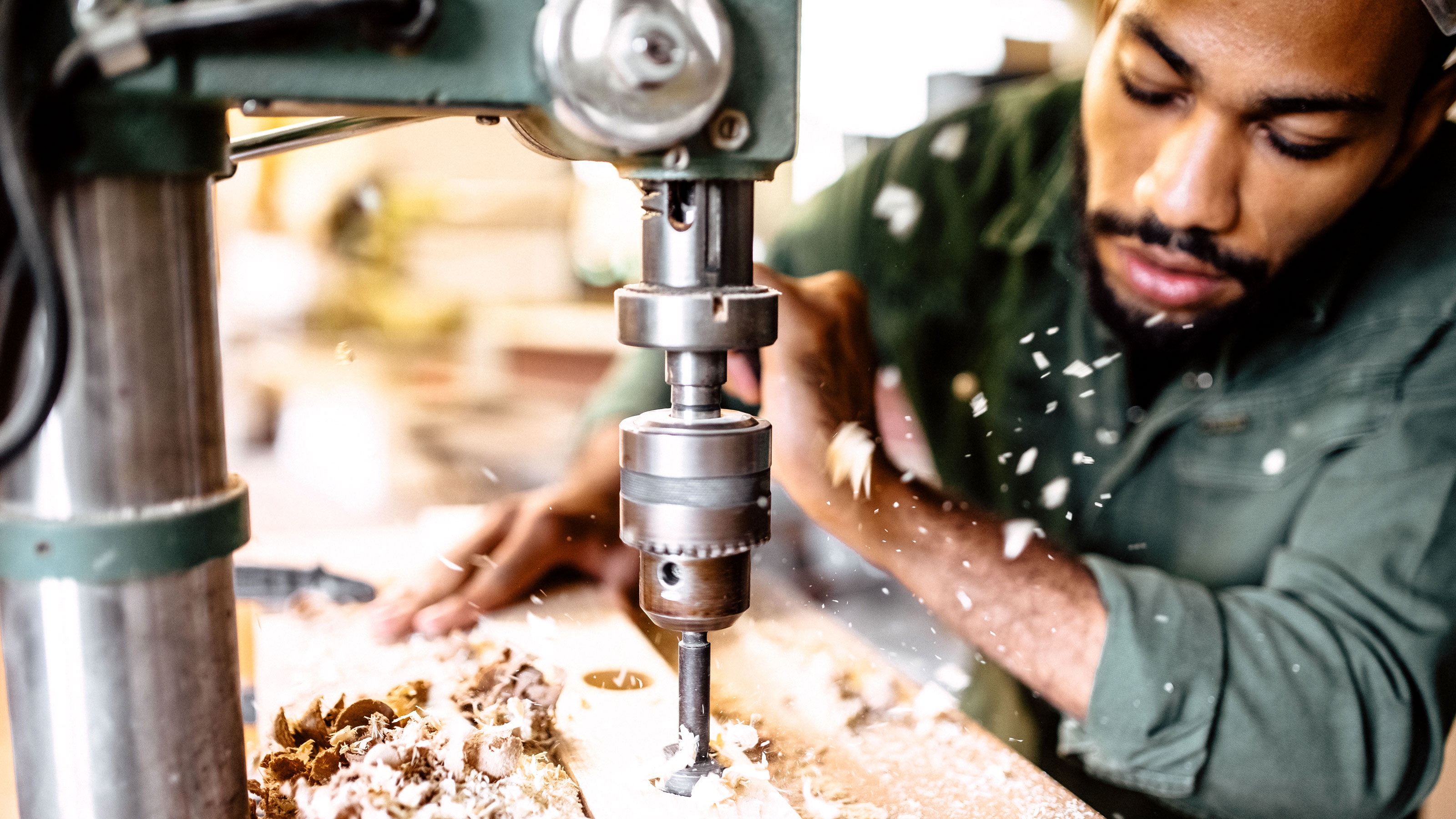What is a pillar drill and why you might need one for your next DIY project
What is a pillar drill? Yes, it's a drill, but it's a specialist type of drill that promotes accuracy every time you use it. Find out more.

What is a pillar drill? You’ve heard the name but you're not sure what they are and what they do. We are here to help you discover what a pillar drill is, what it’s best used for and, more importantly, help you decide if you need one for your latest project.
Unlike the best cordless drills a pillar drill is not an everyday DIY drill, it has a more specific purpose. It's not a hand held power tool, it’s a workshop tool that is standalone or bench mounted and is perfect for consistent, accurate drill holes.
Here we delve into what they are, what they do and how much you can expect to pay for one to help you decide if it is the drill for you.
What is a pillar drill? A quick definition
A pillar drill is a drill that is attached to a metal column with a platform, aka as a table, below to put your chosen material on. A rotating handle moves the drill down the column to drill a hole. Typically, a pillar drill is a floor standing machine that is often bolted to the floor.
But, less expensive models can be mounted to a bench or similar to do their drilling. These are also known as bench drills and are typically used by casual DIYers due to their price.
Why use a pillar drill?
The core purpose of a pillar drill lies in its accuracy. It is far more accurate than a hand held drill thanks to its design. The drill being mounted on a strong metal column means that it doesn't deviate from its course. Each and every time the drill is pulled down the column it will drill in the same place.
The drill platform or table is also attached to the column and can be moved up and down, so the two combined together ensure a straight accurate drill each time. But, some models allow the platform to move to different angles for drilling.
But, it's not just its accuracy that a pillar drill has to offer. Its setup means that you can quickly drill holes (accurately) and apply more pressure to drill through tougher materials precisely.
What materials can a pillar drill drill?
A pillar drill can be used to drill a range of materials, depending on the drill bit. But it is primarily used to drill wood and metal, though it can drill plastic and masonry if needed. You will need the appropriate drill bit to take on a task i.e. a wood drill bit for wood and a metal drill bit for metal.
Pillar drills also give you control over the RPM or spin speed of the chuck. Which gives you greater control over the drilling process and finished hole.
Bring your dream home to life with expert advice, how to guides and design inspiration. Sign up for our newsletter and get two free tickets to a Homebuilding & Renovating Show near you.
It is worth noting that some materials can throw up a lot of dust – like MDF – so make sure to wear a mask like this Trend FFP3 Disposable Dust Mask from Amazon to ensure you are not breathing in unwanted dust that can damage your lungs.
What is the capacity of a pillar drill?
The capacity of a pillar drill refers to the size of the chuck and what size drill bits it can accommodate. Drills with more power typically have a larger chuck which means that they have a larger capacity.
Bench pillar drills typically have a 13mm chuck, while more industrial pillar drills have larger chucks. A 13mm chuck will be big enough for most tasks.
What drill bits can I use in a pillar drill?
You can use standard drill bits, but they must obviously fit the chuck on the pillar drill. There is a host of different types of drill bit, but popular choices when working with wood are forstner, lip and spur and brad point drill bits.
Whatever drill bit you decide to use, you need to get a good quality brand. Fisch is a good choice with plenty of Fisch drill bits to choose from on Amazon.
If looking to drill metal you will need a drill bit made from strong material that is resistant to wear. Remember to use a suitable lubricant like this MOLYSLIP Metal Working Fluid from Amazon, to help prolong the life of your drill bit and give a smooth finish.
How do you change the drill bit on a pillar drill?
A pillar drill is effectively the same as a standard drill in the way that it operates. It will have a chuck like an everyday drill, but they will typically be larger than the best cordless drills that you use for general DIY projects. To change a drill bit you will need the right size chuck key which will typically come with the drill. Some models will come with a keyless chuck.
How much does a pillar drill cost?
The price range for a pillar can vary considerably depending on size and purpose. If you need a floor standing pillar drill for heavy duty drilling rather than occasional drilling for DIY projects you should expect to pay around £1000 for a low priced model and anywhere up to £3000+ for a higher end model.
However, most DIYers and home renovators won't need a floor standing pillar drill. A bench mounted pillar drill like this Einhell TE-BD 750 E Bench Drill from Amazon will be sufficient for most projects. Prices range from around £100 for a low end model up to around £500-£600 for a decent pillar drill/bench drill.
Steve Jenkins is a freelance content creator with over two decades of experience working in digital and print and was previously the DIY content editor for Homebuilding & Renovating.
He is a keen DIYer with over 20 years of experience in transforming and renovating the many homes he has lived in. He specialises in painting and decorating, but has a wide range of skills gleaned from working in the building trade for around 10 years and spending time at night school learning how to plaster and plumb.
He has fitted kitchens, tiled bathrooms and kitchens, laid many floors, built partition walls, plastered walls, plumbed in bathrooms, worked on loft conversions and much more. And when he's not sure how to tackle a DIY project he has a wide network of friends – including plumbers, gas engineers, tilers, carpenters, painters and decorators, electricians and builders – in the trade to call upon.

